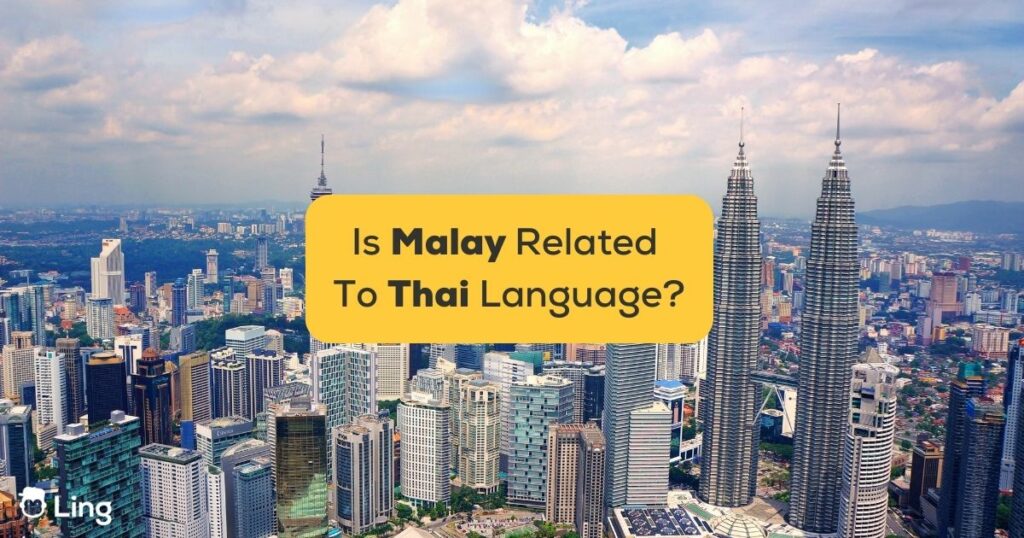“Is Malay related to Thai?” A befuddling query that has marred the minds of many linguistic aficionados and casual language learners alike, gnawing away at their insatiable curiosity. The diverse flavors of Southeast Asia have been a topic of interest far and wide, but today, we’re spelunking past the cultural and culinary gems that steal the spotlight and venturing deep into the mysterious realm of languages in this region. Let’s begin!
What Is The Malay Language About?
Malay, or Bahasa Malaysia as it’s often referred to, is an Austronesian language that takes center stage in a linguistic drama spanning across Southeast Asia. With its roots entrenched in the Malay Peninsula, this linguistical marvel is the mother tongue of over 200 million people across Malaysia, Brunei, Indonesia, Singapore, and parts of Thailand. A bit like a linguistic octopus, its tentacles reach far and wide, making it one of the most widely spoken languages in the world.
While it may be a language with a lengthy geographic reach, the Malay language is surprisingly easy to pick up. Known for its straightforward grammar and pronunciation, Malay has kindly bid farewell to tenses, genders, and plural forms – making language learning less of a wrestling match and more of a friendly handshake.
But make no mistake, the beauty of Malay is not just in its simplicity. It’s also a testament to the region’s colorful tapestry of cultural and historical exchange. It’s studded with loanwords from Sanskrit, Arabic, Portuguese, Dutch, and English, making it a real linguistic potluck.
What Is The Closest Language To Malay?
In the world of linguistics, uncovering the closest language to another is akin to piecing together an elaborate puzzle. In this quest, we turn our lenses to the Malay language, famously known as Bahasa Malaysia, and its nearest relative.
At first glance, one might consider delving into the extensive Austronesian language family for a potential match. However, lay down your microscopic lens and maps because the search endpoint lies blatantly within our sight. The closest language to Malay? The answer is none other than Indonesian or Bahasa Indonesia.
This might seem like a sudden plot twist, but let’s delve into the roots that intertwine these languages. Both stem from the Malay language, which historically functioned as the lingua franca throughout the region. Indonesian, essentially, is a standardized dialect of Malay, established when Indonesia voyaged towards nationhood.
Despite political nuances and minor linguistic variances, Indonesian and Malay remain remarkably similar and mutually intelligible. The differences between the two resemble the disparity between variants of English, like American and British English.
In a nutshell, Malay and Indonesian share linguistic DNA, evolving side by side while resonating the echoes of a shared history. Traces of this influential relationship are audible in the spoken exchanges of their respective speakers, highlighting a deep-seated linguistic bond that transcends man-made borders.

What Is The Thai Language About?
Thai, or as locals call it ภาษาไทย (Phasa Thai), hails from the Tai-Kadai language family. It’s the star of the show in Thailand, serving as both the national language and the medium of education. It’s used from bustling Bangkok all the way up to the rice-clad highlands of the north.
Now, if you’ve flirted with learning Thai, you probably know it’s not a language for the faint-hearted. Thai is a tonal language with five tones – low, mid, high, rising, and falling. The tones are pivotal; change the tone and you change the meaning. Picture saying “Thank you” and accidentally ordering five bowls of spicy noodle soup just by tweaking your tone!
Despite this initial tonal hurdle, Thai has a surprise up its sleeve. Thai grammar is delightfully simple – no verb conjugation, no noun declension, and no pesky articles. The Thai language eagerly says “Sawasdee” (hello) to language learners with open arms (and easy grammar).
Digging into the Thai language’s history reveals that it’s been a linguistic sponge, absorbing and adapting elements from Sanskrit, Pali, Old Khmer, and yes, even English! A perfect blend of local flair and foreign rhythms, the Thai language is a testament to Thailand’s vibrant history and rich culture.
What Is The Closest Language To Thai?
In this section, we’re after the closest language to Thai. Will it be another far-reaching Austronesian? Or a mysterious language from a remote corner of the globe? Buckle up, and let’s unravel the linguistic web to see which contestant snatches the title of Thai’s closest kith and kin in the language arena.
Drumroll, please! The answer is… Lao!
That’s right, folks – Lao (ພາສາລາວ or Phasa Lao) wins the honor of being Thai’s closest linguistic companion. Nestled along the Mekong River, the Lao language makes its home in the charming country of Laos, effortlessly winning hearts with its melodic tones and cultural resonance.
But what makes Lao and Thai such linguistic buddies, you ask? Well, their friendship has been woven since ancient times, both stemming from the Tai-Kadai language family. They’ve got oodles in common: similar vocabularies, grammar structures, and, of course, their shared love for a good tonal workout – Lao rocks six tones while Thai flaunts five.
It’s no surprise that native speakers of Thai and Lao have a smooth sailing communication experience, making them an iconic duo in the linguistic realm. While the scripts are visibly distinct, they still share a familiar origin – both derived from the Old Khmer script, reflecting their rich, intertwined history.

Is Malay Related To Thai?
Within the vast array of Asian languages, comparisons and connections often arise, causing one to question viewed boundaries. When scrutinizing the Malay and Thai languages, it seems natural to consider their possible relational ties. So, how do these richly historical languages connect?
To start with, the Malay language, the official language of Malaysia and Indonesia, thrives in the Austronesian language family tree. This linguistic group has a significant reach, connecting languages from the far-flung territories of Madagascar to Easter Island. This family serves to link numerous island nations spanning across half the globe, creating a vast chain of linguistic relations.
In contrast, Thai, the national language of Thailand, is embedded in the Tai-Kadai language family. This family’s roots trace back to Southern China, exhibiting its geographical origin and cultural heritage distinctively.
Though they belong to different family groups, Malay and Thai share a geographical proximity that has facilitated cultural and lexical exchanges over centuries. Despite their distinctive historical and linguistic backgrounds, certain similar vocabulary entries can be observed in both languages, indicative of their shared regional influence.
So, to sum it up, Malay and Thai are not related or even distant cousins; they hail from different language families. However, they occasionally sneak into each other’s territory, swapping words and phrases like excited school kids trading lunchbox treats. Now isn’t that delightfully intriguing?
Learn The Malay Language With Ling
In conclusion, our linguistic exploration has truly been a thrilling rollercoaster ride, showcasing the depth and breadth of the Malay language. Should the magnetic charm of this linguistic powerhouse tug at your curiosity and entice you to delve further, feel free to join the party at Ling.
As luck would have it, learning Malay is just a tap away with the Ling app, the perfect digital companion for eager knowledge hunters. Simply head to the App Store or the Play Store, download Ling for free, and watch your linguistic prowess grow in leaps and bounds!



































































